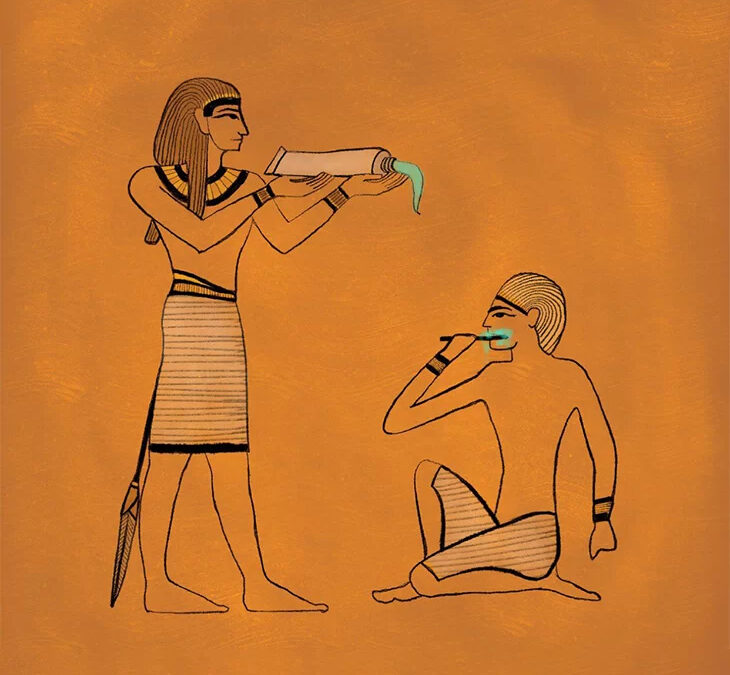Brushing your teeth for two minutes is an excellent time to think about or reflect on your day. But, have you ever considered the roots of the practice? How long have people been brushing their teeth? And when did toothpaste first appear?
The story of brushing your teeth is a story that will smile at you. Starting from its very beginning and up to its new advancements.
When was the first bottle of toothpaste invented?
According to the Pennsylvania Toothbrush Association, humans have used broken bones, sand, oyster shells, and other substances before. They use it to prepare pastes and powders to clean their teeth. They used it as their toothpaste since there wasn’t any commercial toothpaste available yet. In the 1800s, a more traditional toothpaste was created. In 1824, a dentist nicknamed “Peabody” was the first to put soap into a dental paste. And in the 1850s, John Harris introduced chalk.
Twenty years later, Colgate mass-produced the first toothpaste in a jar. Then, for the very first time, toothpaste was mass-produced in 1873. A watershed moment happened in 1892. Dr. Washington Sheffield expressed his opinion on an unclean practice. It is when most of them will be dipping their toothbrushes into the same container.
That year, he created the first foldable toothpaste tube. Artists’ paint tubes are said to have influenced him. A foldable tube that may be adjusted with handy handmade squeezers has been developed. And fluoride was introduced to toothpaste to help avoid cavities in 1914.
Early Egyptian, Greek, Chinese, and Roman literature mention various toothpaste. It is being combined with powder that was used to brush their teeth. Crushed bone, ox hoof ashes, burned eggs, pumice, and oyster shells were common components back then. Finely ground fruit, honey, and dried flowers were among the better-tasting components.
Below is the timeline of the evolution of contemporary toothpaste.
1800s – The invention of “modern” toothpaste, generally in powder form, was made.
1824 – Soap was added to toothpaste by Dr. Peabody.
1850s – Chalk was added to toothpaste by Dr. John Harris.
1873 – The first toothpaste in a jar was mass-produced by Colgate.
1892– The collapsible tube was designed by Dr. Washington Sheffield.
1914 – Toothpaste now contains fluoride.
In today’s era – Whitening formulations and ingredients are emerging. Its main purpose is to guard against gingivitis, plaque, and bad breath. These are among the most modern toothpaste innovations. There is toothpaste for every dental need. And there’s a toothpaste for every set of teeth. Whether you’re searching for one that whitens or a sensitive one.
With various varieties of toothpaste on the market today, choosing the right one can be difficult. Knowing how different types of toothpaste function and what their ingredients are help.
Fluoride is found in almost all toothpaste. For one main reason, it builds tooth enamel and prevents cavities and tooth decay. According to the American Dental Association, brushing with fluoridated toothpaste is recommended. Everyone should brush their teeth using fluoride toothpaste. It can cause an adverse reaction in a small percentage of people, but most people of all ages may enjoy and benefit from it.
- Some toothpaste responds to a certain need or desire. Instead of bleach or other whitening chemicals, whitening toothpaste can scrape away stains. Studies have revealed that these toothpaste are mild enough for regular use. And it will not affect tooth enamel.
- Appropriate toothpaste for sensitive teeth has ingredients like sodium chloride or ammonium nitrate. It can lessen sensitivity or discomfort. So, better use “sensitive teeth” toothpaste regularly.
- Some toothpaste products claim to be tartar or plaque fighters. Plaque removal is a common objective while brushing your teeth. But what does it imply when toothpaste is marketed as “tartar control” toothpaste? Tartar is a hard plaque that must be scraped away with appropriate dental equipment. Antibacterial compounds are commonly found in tartar-control toothpaste. Brushing with any of these toothpaste reduces and eliminates the possibility of plaque and tartar buildup.
- Natural toothpaste frequently contains botanical compounds that are said to be healthier. Most of this toothpaste has not been demonstrated to be effective and safe. Many of them lack fluoride. Make sure you read the labels before purchasing any toothpaste.
For generations, brushing your teeth has been a routine. But contemporary tools and advances in dentistry make excellent oral hygiene easier. Also, it is considered more environmentally friendly than ever before. Make sure to set an appointment with your dentist. So, you can discuss your dental hygiene concerns. Dental hygiene has always been a concern for every generation until this time.
And remember, fluoride doesn’t kill germs; instead, it builds enamel, lowering the risk of cavities. It is vital, but so is brushing your teeth properly and regularly. To eliminate food particles and germs that can cause plaque and gum disease. Also, flossing your teeth once a day can help. It can eliminate food particles stuck between teeth, which a toothbrush can’t even reach.
Dental examinations are recommended twice a year. So, to ensure that your teeth are in good health, brush them. It can help you detect any abnormalities early on, while they are highly treatable. With that much background behind the habit of cleaning our teeth, you might be even more grateful. Especially when you look at your beautiful smile. Brush your teeth at least twice a day for two minutes each time to avoid decay, cavities, and periodontitis. Always remember that brushing is fun. So, why not make it a habit now?
